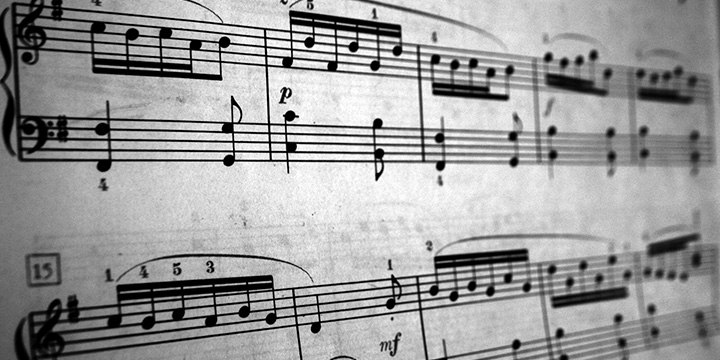A Basic Guide to Italian Dynamic Markings in Classical Music
“French! Spanish! Latin! Mexican!” These were shouts of young violin players answering the question, “What language did Beethoven use in his notation in the Symphony No. 3 Scherzo that I just performed?” Curious, but off-course, these students are not alone in finding mystery in common musical notation.
Yes, music is the universal language, but the majority of Western classical music has been notated by composers with markings in Italian. So, in order to follow the composer’s notated musical instructions, a player must adopt a few Italian words into their lexicon, along with their symbols and meanings.
Of these Italian words, there is a huge group designated to signify dynamics. Dynamics are the aspect of music relating to degrees of loudness. This can range from whisper-soft to rock-concert loud. This variation in loudness allows for changes in mood, the addition of emotion, the feeling of movement and the prevention of boredom. So, when your eyes meet the written mastery of Bach, Beethoven or Brahms, scan your eyes underneath the staff for those Italian dynamic instructions.
Here is a list of the most common dynamic markings that can be found in nearly all Western classical music.
Relative Loudness Dynamics
Pianississimo
Musical symbol: ppp | Meaning: very, very soft

Example: Violin I of Mahler Symphony No. 1, Movement I
Pianissimo
Musical symbol: pp | Meaning: very soft

Example: Violin I of Beethoven Symphony No. 3, Movement III: Scherzo
Piano
Musical symbol: p | Meaning: soft

Example: Piano Sonata No. 14 “Moonlight,” Movement II
Mezzo-piano
Musical symbol: mp | Meaning: soft

Example: Symphony No. 9 by Antonin Dvorak
Mezzo-forte
Musical symbol: mf | Meaning: loud

Example: Cockaigne Overture by Edward Elgar
Forte
Musical symbol: f | Meaning: loud

Example: Swan Lake Suite by Pyotr Tchaikovsky
Fortissimo
Musical symbol: ff | Meaning: very loud

Example: Violin I Great Gate at Kiev from Pictures at an Exhibition by Modest Mussorgsky
Fortississimo
Musical symbol: fff | Meaning: very, very loud

Example: Rite of Spring by Igor Stravinsky
“Dynamics are not indications of the decibel level of the playing,” Simon Fischer explains in “The Violin Lesson.” Instead, they are relative indications of loudness. Therefore, a change in dynamic to mp should be louder than p and softer than mf, for example.
Occasionally, you will see a pppp or ffff. Follow the pattern. The more “p”s, the quieter, the more “f”s, the louder. With ffff, yes, you may feel the need for earplugs; pppp might give you the false assumption that you’ve experienced hearing loss. You probably haven’t, but it is possible the composer intended it to be barely audible.
Gradual Changes in Dynamics
Classical music, in general, is very dynamic. As a listener, we go through a journey that involves a lot of ups and downs in sound level. This isn’t just an audible difference; there are ways to read these changes in dynamic.
Crescendo
Musical symbol: cresc. and/or < | Meaning: gradually get louder
Diminuendo
Musical symbol: dim. or decresc. and/or > | Meaning: gradually get softer

Example: Salud D’Amour by Edward Elgar
Sudden Changes in Dynamics
Sforzando
Musical symbol: sfz, sf, or fz | Meaning: accented or suddenly loud

Example: Rite of Spring by Igor Stravinsky
Sforzando piano
Musical symbol: sfp | Meaning: sforzando (accented or suddenly loud), followed by piano (soft)

Example: Mozart Symphony No. 39, Movement I
Forte Piano
Musical symbol: fp | Meaning: loud, then immediately soft

Example: Violin Concerto in D Major by Johannes Brahms
Mezzoforte Piano
Musical symbol: mfp | Meaning: medium strong, then immediately soft

Example: Mozart Symphony 39 movement IV
Whether you want to play Beethoven with gusto or Brahms with fire, dynamics are fundamental in creating such sounds. Thus, keeping these Italian words, their symbols, and musical meanings in our memory banks will help us interpret the composer’s intention with integrity. Buona fortuna! Ciao!
FONTE: https://reverb.com/news/a-basic-guide-to-italian-dynamic-markings-in-classical-music
Julian Ludwig é diretor do Pro Áudio Clube, produtora de áudio Jacarandá, Loc On Demand e Jacarandá Licensing. Trabalhou para empresas como: Guaraná Antartica, TV Gazeta, NET, Chivas Regal, FNAC, Prefeitura de São Paulo, Mukeca Filmes, Agência LEW’LARA TBWA, Agencia MPM, Agência Content House entre outras. Fez trilhas para programas de TV como: Internet-se (Rede TV), Você Bonita (TV Gazeta), Mix Mulher (TV Gazeta), Os Impedidos (TV Gazeta), Estação Pet (TV Gazeta), CQC (TV Band) Vinheta Oficial TV Gazeta, entre outras. Também atuou em vários longas e curtas metragens, incluindo mixagem em 5.1 e serviços de pós-produção.

